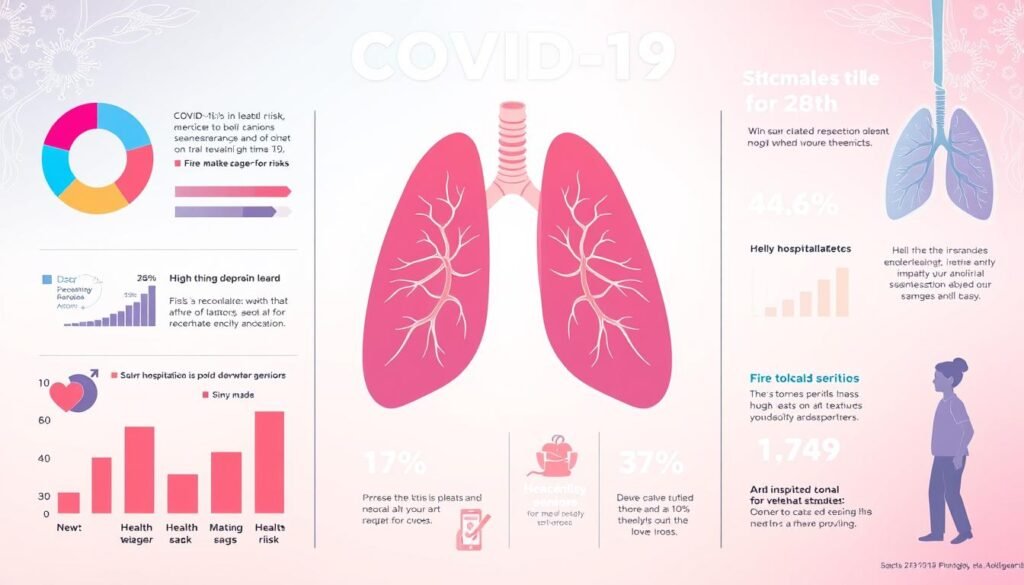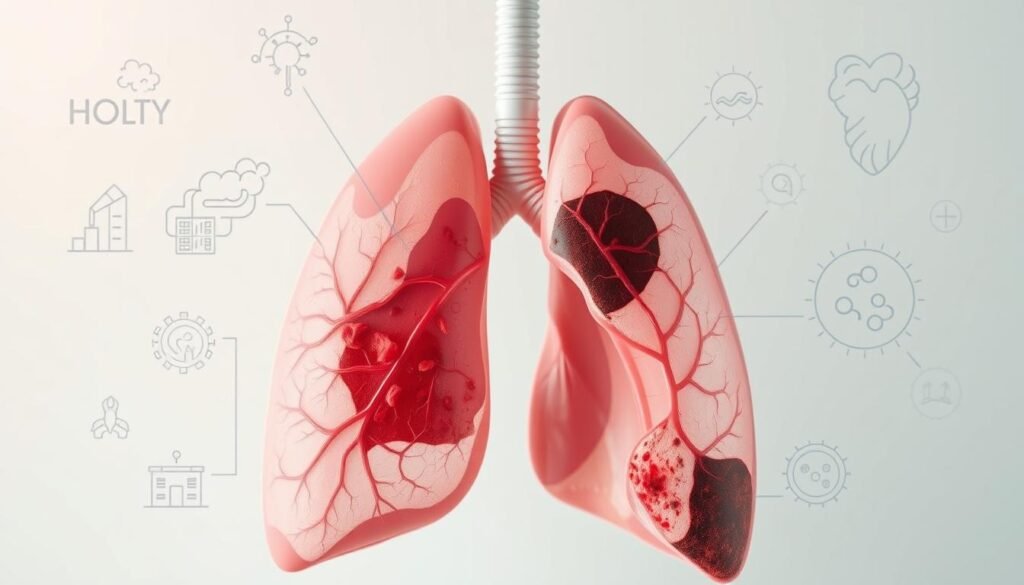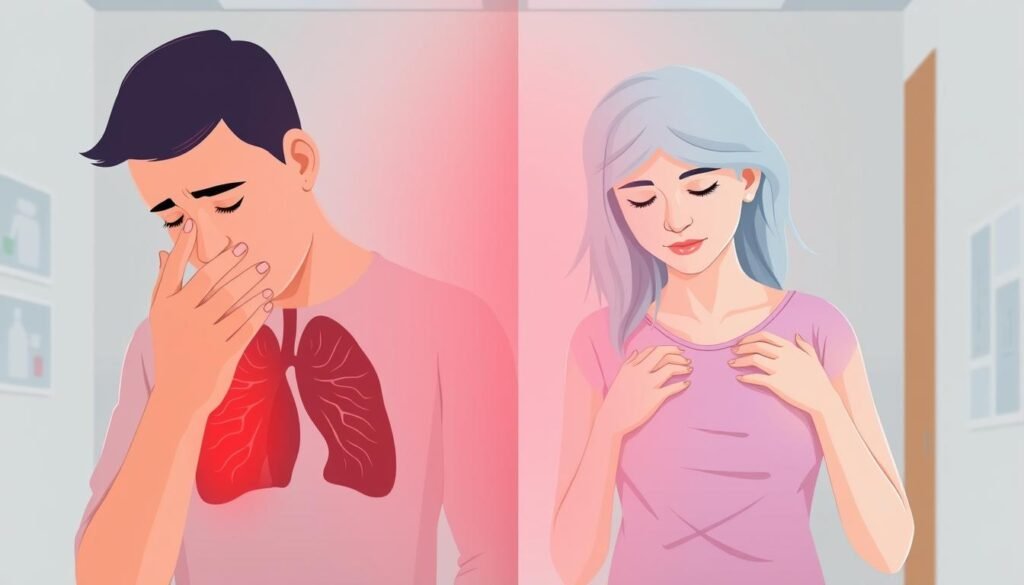More than 556 million confirmed COVID-19 cases have been reported globally, leading to nearly 6.35 million deaths by mid-July 2022. This highlights the pandemic’s deep effect on vulnerable groups. Seniors and those with lung conditions are at higher risk. Older people, over 65, face serious risks from the virus. Their weakened immune systems and lung issues make them more susceptible. Plus, lung cancer patients are even more at risk because of weakened immunity.
Understanding these risks is key. It helps us protect seniors and those with chronic lung conditions better. Making special health plans for them can improve their outcomes greatly.
The impact of COVID-19 on the elderly and people with lung diseases needs careful study. Research into how gender and other health issues affect this is important. Lung cancer patients, for example, have a higher death rate from COVID-19. This shows the need for special attention and prevention for them.
For more on how biology plays a role in lung cancer risks and outcomes, see this helpful article. It talks about why we should care about lung cancer patients’ unique needs.
Explore more about lung cancerand COVID-19
Key Takeaways
- COVID-19 poses significant risks, particularly for seniors and individuals with chronic lung conditions.
- Older adults, especially those over 65, are at higher risk for severe COVID-19 complications.
- Lung cancer patients show heightened vulnerability to severe COVID-19 outcomes and mortality.
- The necessity for tailored prevention and treatment approaches is critical for older adults with lung conditions.
- Understanding the complex interplay between age, comorbidities, and gender can enhance care strategies.
Understanding COVID-19 and Its Risks
COVID-19 is caused by the SARS-CoV-2 virus and is especially dangerous for older adults and people with current health issues. It is mainly spread through respiratory droplets. This lets the virus move quickly in different settings. Common symptoms are fever, cough, and shortness of breath. In serious cases, it can cause intense lung problems and harm multiple organs.
Studies show that high-risk groups include seniors with diseases like heart issues, diabetes, and lung conditions. They have a higher chance of serious problems from COVID-19. Knowing these risks helps with treating and preventing the disease effectively. A detailed study compares how COVID-19 affects lung cancer patients differently than those with other cancers. This insight is key for understanding death rates, ICU needs, and pneumonia in these patients. This information guides healthcare in fighting the pandemic.
| Health Condition | Severity Risk | Notes |
|---|---|---|
| Older Adults | High | Increased vulnerability due to age-related health decline. |
| Chronic Lung Conditions | Very High | May lead to severe respiratory issues. |
| Cardiovascular Disease | High | Compromises heart function, adding to the severity of COVID-19. |
| Diabetes | High | Can weaken the immune system and complicate recovery. |
It’s important for both healthcare systems and people to stay aware of these risks. This helps us face the ongoing challenge of COVID-19.
Statistics on COVID-19 Severity in Seniors
COVID-19 has hit different groups hard, especially seniors. Stats show that people over 65 are mostly in hospitals because of this virus. They are 23 times more likely to die than younger folks. In the U.S., about 76% of COVID-19 deaths are among those 65 and older.
The risk of getting really sick goes up after age 75. Seniors often have worse cases of pneumonia, affecting many parts of their lungs. This leads to more hospital stays and deaths. Plus, half of those over 60 show typical COVID-19 signs like fever, cough, and breathing trouble.
Seniors with other health problems face even tougher battles. Tests show high D-dimer levels and other markers that predict bad outcomes. Being older is a bigger factor in getting severely ill than just having chronic diseases.
| Age Group | Hospitalization Rate | Mortality Rate |
|---|---|---|
| Aged 65 and older | 80% | 76% |
| Aged 70-79 | Higher rate | 8.0% |
| Aged 80 and older | Higher rate | 14.8% |
It’s critical to keep a close eye on COVID-19 numbers for seniors. We need effective plans to reduce the virus’s impact on this group.

Chronic Lung Conditions: An Overview
Conditions like chronic obstructive pulmonary disease (COPD) and asthma greatly impact older adults. These diseases lead to less lung function. This makes people more open to respiratory infections, such as COVID-19.
Studies show that seniors with lung diseases face a higher risk of serious COVID-19 complications. It’s vital to manage these conditions well to improve respiratory health. Things like regular check-ups, sticking to medication, and lifestyle changes can lower risks from these lung problems.

Studies on chronic lung conditions help us understand their effect on respiratory health and treatment options. This knowledge leads to better care, improving patient outcomes and lives.
| Chronic Lung Condition | Common Symptoms | Management Strategies |
|---|---|---|
| COPD | Shortness of breath, chronic cough, wheezing | Bronchodilators, corticosteroids, pulmonary rehabilitation |
| Asthma | Chest tightness, coughing, difficulty breathing | Inhalers, allergy management, lifestyle adjustments |
| Interstitial Lung Disease | Dry cough, fatigue, unexplained weight loss | Anti-inflammatory medications, oxygen therapy, pulmonary rehab |
Dealing with chronic lung conditions properly, especially in older people, leads to better respiratory health management. A full treatment approach helps control symptoms and reduces the risk of serious respiratory disease outcomes.
The Impact of Age on COVID-19 Outcomes
Age plays a big role in how COVID-19 affects people, especially the elderly. Older adults face a decline in their immune system known as immunosenescence. This makes it hard for them to fight off infections. As a result, they are more likely to get hospitalized or die from the virus.
Research shows that older adults have more inflammation in their bodies. This, combined with a weaker immune system, increases their risk from COVID-19. Understanding these risks is crucial. We must focus on creating guidelines to protect our seniors during the pandemic.
To grasp how age affects COVID-19 outcomes, here’s a table showing key factors for the elderly:
| Age Group | Immunosenescence Effect | Hospitalization Rate | Mortality Rate |
|---|---|---|---|
| Seniors (65+) | Significant decline in immune response | Higher than younger populations | Increased severity leading to higher mortality |
| Middle-aged (45-64) | Moderate decline, varying by health status | Moderate rates of hospitalization | Lower mortality compared to seniors |
| Young Adults (18-44) | Minimal impact on immune response | Lowest hospitalization rates | Very low mortality rates |
Learning about these patterns reveals the big impact of age on COVID-19 outcomes. We need tailored health strategies and policies for seniors. By keeping a close watch on the elderly, we can protect them better in this health crisis.
Gender Differences in the Presentation of NSCLC
Studies show important gender differences in how non-small cell lung cancer (NSCLC) appears. Understanding these differences is key. It helps us see how lung cancer impacts men and women differently. We’ll look into unique symptoms and how hormones play a role for each gender.
Understanding Gender-Specific Symptoms
Men and women experience lung cancer symptoms differently. Men are more likely to be diagnosed with NSCLC at later stages. Women, however, often have a chronic cough and feel tired. These differences highlight the need for better awareness about the role of body and environment in cancer.
The Role of Hormonal Influences in Lung Diseases
Hormones, especially estrogen, affect lung cancer growth and behavior differently in women. Women with NSCLC are more likely to get adenocarcinomas and have tumors of a lower grade. This shows why treatments should be personalized, considering these gender-based differences.

| Aspect | Men | Women |
|---|---|---|
| Incidence Rate (2006) | 70 per 100,000 | 52 per 100,000 |
| Common Diagnosis | Advanced NSCLC | Adenocarcinoma |
| Average Survival Rate | Varies | Better survival rates at early stages |
| Smoking History Influence | More likely smokers | Higher percentage of never-smokers developing NSCLC |
| Symptoms Experienced | Less fatigue | Chronic cough and fatigue more pronounced |
It’s essential to understand the gender differences in NSCLC and how hormones influence it. Knowing these can improve how we diagnose and treat lung cancer. Customized treatment plans can greatly enhance the quality of care for everyone with lung cancer.
Comorbidities and Their Effects on COVID-19 Severity
Comorbidities play a big role in the severity of COVID-19, especially in older individuals. Conditions like heart disease, diabetes, and being overweight make it harder to deal with respiratory infections. It’s important to know how these health issues affect COVID-19 to help patients get better.
The Role of Cardiovascular Disease and Diabetes
Heart disease and diabetes make COVID-19 worse. Men, who often have heart problems, are at greater risk when they catch COVID-19. Around 11.4 million cases globally show this danger. Diabetes also leads to more severe cases, mainly in men who have it more often than women.
Impact of Obesity on Aging Populations
For older people, being obese is a major risk. A BMI over 30 means higher chances of needing hospital care from COVID-19. It adds to the challenge of treating COVID-19 effectively. Scientists say we need good ways to handle obesity in the elderly to lessen COVID-19 risks.
Working on better awareness and management of comorbidities helps with health plans. This could greatly help those at risk. For tips on prevention, check out the benefits of vaccines in improving health and cutting down severe cases.
| Comorbidity | Impact on COVID-19 Severity |
|---|---|
| Cardiovascular Disease | Increased risk of severe manifestations |
| Diabetes | Higher likelihood of complications and hospitalization |
| Obesity | Significantly raises risk of respiratory distress and severe illness |
Preventative Measures for Seniors
For seniors, taking steps to stay safe from COVID-19 is critical. Because they’re at higher risk, it’s vital to follow specific COVID-19 protection strategies. These steps help keep them safe.
Washing hands often and wearing masks in busy places are key defenses. Staying away from others helps avoid the virus. Highlighting these health guidelines creates a safer environment.
Getting vaccinated is a key part of staying safe from COVID-19. It’s important to make sure seniors get their vaccinations. Programs that make vaccines easier to get can help.
Regular health check-ups can catch COVID-19 problems early. This complete approach helps seniors stay on top of their health. It helps them take the right steps to stay safe.
Overall, following health guidelines and taking action early keeps seniors safer. During these tough times, these steps can improve their health and safety.
Vaccination: Importance for Older Adults and Those with Lung Conditions
Vaccines are vital for older adults and those with lung issues. They help avoid serious COVID-19 complications. Seniors get less sick, visit the hospital less, and face a lower death risk if vaccinated. This is essential for folks with lung problems like COPD.
Getting older increases the risk of pneumococcal pneumonia. It’s 2.7 times more likely in those over 65 than in people 50-64. Those with lung diseases face even higher risks. Pneumonia, COPD, and asthma are major reasons for hospital stays. So, doctors push for vaccines for these high-risk patients.
Vaccines matter more with rising chronic illness in seniors. About 61.6% of people over 65 have multiple chronic conditions. This ups their infection risk. So, keeping up with vaccines is key.
Vaccines don’t just protect the person; they help everyone by stopping COVID-19 spread. It’s crucial that older adults and lung condition patients get their shots. Boosters too. Focusing on vaccine benefits and making them easy to get can improve health for these at-risk groups.
| Condition | Risk Increase (≥65 years) | Hospitalization Rate |
|---|---|---|
| Pneumonia | 2.7 times higher | 55.7% of respiratory hospital admissions |
| COPD | 7.7 times higher for those with CRD | 1.1 million hospitalizations annually in Europe |
| Asthma | Twice as high in comparison to other adults | 47.3% of respiratory deaths in EU |
Conclusion
The impact of COVID-19 on seniors and people with lung conditions shows we need strong health plans for them. Age and gender differences, along with other health issues, play a big role in their health. Knowing this helps create better ways to manage and prevent health problems for these groups.
Our healthcare systems have to focus on helping seniors and those with lung issues. This means getting them vaccinated, offering treatments that meet their needs, and taking steps to prevent illness. Improving the health of these people is key in dealing with the effects of the pandemic.
The situation is always changing, so we can’t stop trying to understand and solve the problems these individuals face. Our ongoing efforts are crucial for their health and happiness.